
How to Pass on Family Heirlooms with Fewer Estate Battles
Family feuds are more likely over Aunt Josephine’s jewelry than the family home. Putting sticky notes on personal items before you die or expecting heirs to figure things out after you’ve passed often leads to ugly and expensive disputes, says a recent article from The Wall Street Journal, “Pass On Your Heirlooms, Not Family Drama.”
Boomers handling parents’ estates and assessing their personal property are having more conversations around inheritance and heirlooms. However, there are better ways to plan and distribute property to avoid family fights over cars, jewelry, furniture and household items.
The person you name to handle your estate, the executor, typically distributes personal property. Therefore, pick that person with care and clarify how much power they will have. An example of this comes from a police officer in Illinois who has been settling his father’s estate for nearly two years. His father owned more than twelve vehicles, a water-well drill rig and two semitrailers of car parts and guns dating back to the Civil War. He also listed 19 heirs, including stepchildren and friends. He told his son he knew he could handle everyone and the stress of people who “aren’t going to be happy.”
If you want a particular item to go to a specific person, make it clear in your will or trust. Describe the item in great detail and include the name of the person who should get it. A sticky note is easily removed, and just telling someone verbally that you want them to have something isn’t legally binding.
Without clear directions, one family with five siblings used a deck of cards and played high card wins for items more than one sibling wanted. Only some families have the temperament for this method.
In one estate, two sisters wanted the same ring. However, there were no directions from their late parents. An estate settlement officer at their bank had a creative solution: a duplicate ring was made, mixed up with materials from the original ring, and each daughter got one ring.
Ask your estate planning attorney how to address personal heirlooms best. In some states, you can draft a memo listing what you want to give and to whom. It is legally binding, if the memo is incorporated into a will or trust. If not, the personal representative can consider your wishes. Make sure to sign and date any documents you create.
Get heirlooms appraised to decide how to divide items equitably, which to sell and what to donate. If heirs don’t want personal property, they can donate it and use the appraisal to substantiate a tax deduction. Appraisals will also be needed for estate tax and capital gains tax purposes.
Reference: The Wall Street Journal (July 30, 2023) “Pass On Your Heirlooms, Not Family Drama”









